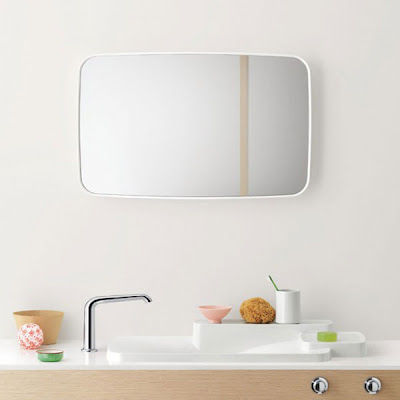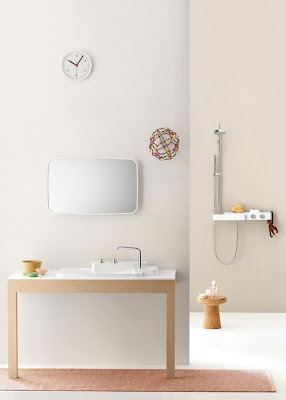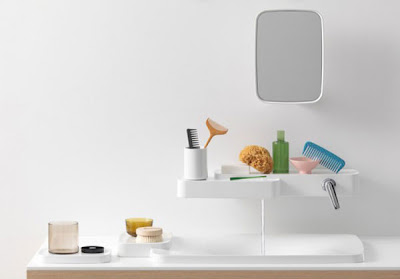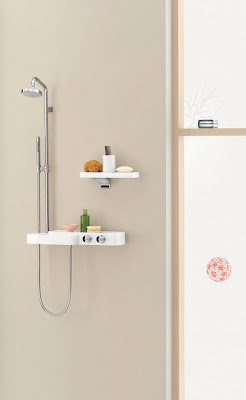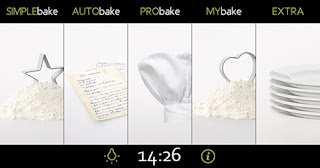While I was in Germany last month I saw this vanity. Notice how the shelf over the sink is also the faucet.
Pretty cool idea and I love all of the tiered surfaces surrounding that sink. I learned while I was there that this sink and shelf are part of a new collection from Axor, the leading edge of the Hansgrohe brand. Brothers Ronan and Erwan Bouroullec designed a collection of some 70 components that are intended to be mixed and matched to make a fully custom bath design.
A big part of that is that the sinks and tubs aren't pre-dilled. All you need is a carbide-tipped bore and you can have your faucets be anywhere you want them. That is a great idea. Here are some glamor shots of the collection.
My pals at Hansgrohe tell me that the Axor Bouroullec is already available in Europe and will be coming to North America this summer. You can see all of the components from the Axor Bouroullec on Axor's international website.
28 February 2011
Ronan and Erwan Bouroullec rethink the bathroom for Axor
Posted by
Paul Anater
Labels:
bath design,
bath fixtures
27 February 2011
Homeier debuts a new idea in ventilation
Posted by
Paul Anater
Check this out.
Those three things are functioning as a ventilation hood. It's a really neat idea. Each of those three towers, for lack of a better term, is 560mm tall and 180mm wide, is attached to the counter, rotates 270 degrees, and uses a remote blower to do the actual ventilating.
What I'm showing you here is the Alia from Homeier and it represents something really new in ventilation. The Alia towers can be combined in groups of two, three, four or five, depending on the need. Kitchen pros, here's the spec sheet.
I can see using these on an island as an alternative to dropping a hood from the ceiling. Their height would make them more effective than a pop up extractor and that the individual units rotate just adds to that effectiveness. Great idea Homeier. What do you guys think?
Those three things are functioning as a ventilation hood. It's a really neat idea. Each of those three towers, for lack of a better term, is 560mm tall and 180mm wide, is attached to the counter, rotates 270 degrees, and uses a remote blower to do the actual ventilating.
What I'm showing you here is the Alia from Homeier and it represents something really new in ventilation. The Alia towers can be combined in groups of two, three, four or five, depending on the need. Kitchen pros, here's the spec sheet.
I can see using these on an island as an alternative to dropping a hood from the ceiling. Their height would make them more effective than a pop up extractor and that the individual units rotate just adds to that effectiveness. Great idea Homeier. What do you guys think?
Labels:
appliances
26 February 2011
Can a sofa cause cavities?
Posted by
Paul Anater
In looking over the Mon Amour collection from Italian manufacturer Desart, I would say the answer is yes.
I know, I know, there's room for everybody. But really?
A lot of effort went into these pieces, and they're very well made. But still.
They're fully customizable too.
Is it me or does this combination of stain and upholstery look like the queen bee alien from Alien?
Argh. What do you think?
Labels:
furniture
25 February 2011
I'm asking again, Gorenje please come to North America
Posted by
Paul Anater
The Slovenian appliance manufacturer Gorenje has been on my radar for around the last two years. They make exceptionally well-designed and well-priced appliances and they're only sold on the other side of the Atlantic. When Blanco had me in Germany last month to attend The Living Kitchen and IMM it was painful to see the number of innovative, new things that never make it to the US and Canada.
So on my first day at the show I was walking the floor and I turned a corner and saw this.
At long last. I'd been reading about this company's products for ages and finally, I'd get to see them for myself.
I was beyond impressed with all of their offerings but what really got me was a wall oven they're calling the iChef+. It is a wall oven that looks as if it has an iPad embedded in it.
the iChef+ takes the idea of programming the setting on an oven to a level I never thought was possible. It has to temperature or timer controls. Rather, it has a hi-def touch pad that walks you through anything you want to bake with a simplicity that masks the complex programming you're actually doing with noteworthy perfection.
The home screen looks like this.
From here you pick any of the oven's five modes. So if I just want to bake something conventionally, then I'd just pick SIMPLEbake. By selecting that, I get a menu that looks like this.
There are nine options that pop up and you just scroll through them to find the kind of food you want to bake. The oven then works conventionally.
If you choose the AUTObake mode, the oven takes over a bit more. Select the kind of food you're baking and the oven tells you which kind of baking pan to use. You tell it the size of the portion you're baking how well done you want your food and what time you'd like to serve dinner. The oven then sets the temperature and time by itself. No guess work involved. So if you want to make prime rib but don't know how, the oven does so just get out of the way and let it.
PRObake allows you to program up to three temperature changes over the course of baking or roasting something. That's revolutionary, frankly. I cook a lot and a lot of foods require temperature changes while they're in the oven. Setting and resetting the timer and temperature is a pain in the butt and I'd kill for a way to program all of that in advance.
Not only that, once you set your cooking program in the PRObake mode you can save your recipe to MYbake.
This means you only have to program these settings once. So the prime rib temperature combo you've perfected can be saved as My Prime Rib in the MYbake library and the next time you make it, all you need to do is click on the title of your recipe. Slick!
Finally, the EXTRA mode holds all of this oven's additional features.
Note that it has a defrost mode and this is a convection oven, not a microwave. I'm as impressed as I remember it as I was when I was playing around with the controls.
Gorenje has a video that goes through the features of the iChef+ and what it communicates better than anything is how easy this oven is to use.
So after seeing that, maybe you can join my petition drive to get Gorenje to cross the pond. Please.
Labels:
appliances
24 February 2011
Finally; Something new, gorgeous, European and available in North America
Posted by
Paul Anater
This is the Tuna wash basin from the Swiss manufacturer Laufen. How it gets its name is pretty self-evident. It's slick, streamlined and I think it's absolutely beautiful. There's a growing trend to have the sink and counter be made from the same vitreous china as a single piece and this is one of the loveliest expressions of that trend I've ever seen.
I've spent the last five weeks looking over and writing about beautiful new products that aren't available in North America and it's a real pleasure to write about one that's actually here. Thank you Laufen.
Labels:
bath design
It's a Coverings Tweet Up. Officially.
Posted by
Paul Anater
Coverings, the great North American tile and stone show has always been at the forefront of new media. They're extremely blogger positive, they maintain a lively Facebook presence and more than any other trade show I know, they embrace Twitter.
Coverings is in Las Vegas' Sands Expo and Convention Center this year and the show's running from March 14 through the 17th. They've also asked me to host an official Coverings Tweet Up. If you've never heard that expression before, a Tweet Up is a real-life meeting of people who use Twitter.
So all you tile and stone Twitterers, we're meeting up at 4pm on Monday, March 14th. We'll meet next to the Installation Design Showcase, booth #178 A-C. That's also next to the bar. I'll have drink tickets to distribute so the first round's on Coverings.
Look for more Twitter and other social media platform-based promotions during the entire three days of the show. If you don't already, follow Coverings on Twitter, Like them on Facebook and Link to them on LinkedIn. Remember too to use the hashtag #Coverings2011 in your Coverings-related Tweets so we know you're out there. See you in Vegas!
Labels:
tile
23 February 2011
One more reason to avoid Anthropologie. Make that three.
Posted by
Paul Anater
A while back, an intrepid member of the K&RD Community (it was Sharon) sent me an alert to another offense being perpetrated by the craven minds at Anthropologie. Tell me, in what universe is this an attractive and desirable sofa?
What would possess someone to produce a sofa like this and then have the gall to charge $6000 for it? Look at these charming details.
This one's even worse than the green one.
I suppose it's some kind of Haunted House chic.
Even worse than the sofas is this chaise.
Let's zoom in on the quality construction. Remember, this thing sells for nearly four grand.
These pieces were designed by Clarke and Reilly, a London-based husband and wife design team. Apparently, Clarke and Reilly bring their moth-eaten sensibilities to everything they touch. The copy traveling through the internet alongside these pieces is full of the usual, meaningless buzzwords. "Organic," "vintage," "natural," they're all here and they're harnessed craftily to disguise the fact that these are some ugly pieces of furniture.
Look, I get it that there's room for everybody's sensibilities in the world and I understand being provocative. However, when I see something like this, I think what's really going on is a cynical worldview at work. It's almost as if people design things that are purposely ugly and expensive just to see how gullible people really are. I get it too that I may be completely out to lunch here but you tell me. Would you allow any of these pieces near your home?
What would possess someone to produce a sofa like this and then have the gall to charge $6000 for it? Look at these charming details.
This one's even worse than the green one.
I suppose it's some kind of Haunted House chic.
Even worse than the sofas is this chaise.
Let's zoom in on the quality construction. Remember, this thing sells for nearly four grand.
These pieces were designed by Clarke and Reilly, a London-based husband and wife design team. Apparently, Clarke and Reilly bring their moth-eaten sensibilities to everything they touch. The copy traveling through the internet alongside these pieces is full of the usual, meaningless buzzwords. "Organic," "vintage," "natural," they're all here and they're harnessed craftily to disguise the fact that these are some ugly pieces of furniture.
Look, I get it that there's room for everybody's sensibilities in the world and I understand being provocative. However, when I see something like this, I think what's really going on is a cynical worldview at work. It's almost as if people design things that are purposely ugly and expensive just to see how gullible people really are. I get it too that I may be completely out to lunch here but you tell me. Would you allow any of these pieces near your home?
Labels:
foolishness,
furniture
22 February 2011
Gaggenau just raised the bar on induction cooktops
Posted by
Paul Anater
When Blanco had me over in Germany last month I saw a nearly overwhelming number of new and innovative products at The Living Kitchen, the trade show I attended in Cologne. Until I got to Germany, I never really thought about how alone in the world the US is with regard to its design sensibilities and I never fully grasped that really innovative products don't debut here. More than anything else, my trip to Germany was an education in how the world works and it was pretty humbling.
I've talked about a lot of the innovations I saw there. The skinny counters, the drain switches, the overflow drains on kitchen sinks, the wide use of laminates and the total dearth of raised-panel cabinet doors were fascinating to see and to report on. More than anything else I saw in Germany though, a new induction cooktop from German manufacturer Gaggenau was the real star at The Living Kitchen.
I'm fascinated by the concept of zoned induction. By zoned induction I mean induction cooktops that dispense with the idea of round burners and turn the whole cooktop surface into an induction zone. There are a couple of European manufacturers playing around with this idea, and none of these models are being exported to the US. Not yet anyway but they're coming. Eventually.
Gaggenau has raised the bar on zoned induction with something called FreeInduction.
The Gaggenau CX 480 uses 48 micro inductors that work together to sense the size and number of any pots or pans set down on the surface. So if you have a rectangular roasting pan and you want to make gravy in it and you have a round pot for steaming broccoli and a third round pot for boiling potatoes, you set all three on the cooktop however they'll fit. The cooktop can tell their sizes and shapes and only activates the induction zone beneath each one. Make sense? No? Watch this video.
Even more amazing than the technology underneath the glass is the touch screen interface that controls the cooktop. Did you catch how that works on the video? It's brilliant. That each control that pops up in response to a pot or pan has its own, separate timer just adds to the genius of this thing.
Induction cooktops are here to stay so get used to them gang. They're a small but growing presence in the US and Canada and you can count on their increasing prevalence. Innovations such as Gaggenau's FreeInduction are a real thrill to see because they represent a complete rethinking of The Way We Do Things. Not only that, they're just cool. Now if they were only available in North America...
I've talked about a lot of the innovations I saw there. The skinny counters, the drain switches, the overflow drains on kitchen sinks, the wide use of laminates and the total dearth of raised-panel cabinet doors were fascinating to see and to report on. More than anything else I saw in Germany though, a new induction cooktop from German manufacturer Gaggenau was the real star at The Living Kitchen.
I'm fascinated by the concept of zoned induction. By zoned induction I mean induction cooktops that dispense with the idea of round burners and turn the whole cooktop surface into an induction zone. There are a couple of European manufacturers playing around with this idea, and none of these models are being exported to the US. Not yet anyway but they're coming. Eventually.
Gaggenau has raised the bar on zoned induction with something called FreeInduction.
The Gaggenau CX 480 uses 48 micro inductors that work together to sense the size and number of any pots or pans set down on the surface. So if you have a rectangular roasting pan and you want to make gravy in it and you have a round pot for steaming broccoli and a third round pot for boiling potatoes, you set all three on the cooktop however they'll fit. The cooktop can tell their sizes and shapes and only activates the induction zone beneath each one. Make sense? No? Watch this video.
Even more amazing than the technology underneath the glass is the touch screen interface that controls the cooktop. Did you catch how that works on the video? It's brilliant. That each control that pops up in response to a pot or pan has its own, separate timer just adds to the genius of this thing.
Induction cooktops are here to stay so get used to them gang. They're a small but growing presence in the US and Canada and you can count on their increasing prevalence. Innovations such as Gaggenau's FreeInduction are a real thrill to see because they represent a complete rethinking of The Way We Do Things. Not only that, they're just cool. Now if they were only available in North America...
Labels:
appliances
21 February 2011
Sensational Scavolini
Posted by
Paul Anater
One of the runaway hits at the Interior Design Show in Toronto last month was the debut of Tetrix, a new kitchen collection from Italian manufacturer Scavolini. Tetrix is the handiwork of design Michael Young and he was in Toronto to announce the debut.
In Tetrix, Scavolini decreased the number of sizes while increasing the number of options available in each cabinet. The result is a kitchen program that's even more customizable that it would be otherwise.
The Tetrix doors are available in a wide variety of colors and every door and drawer front is actually covered in fingerprint-proof etched glass. The glass is perfectly flush mounted and the entire line's been designed and engineered to work without additional hardware.
Tetrix is available in North America and and if you find yourself in New York, stop in the Scavolini showroom on West Broadway in Soho. Daniele and the rest of the staff there would be delighted to show you the line and the rest of the kitchens available from Scavolini.
Labels:
kitchen design
20 February 2011
A Houzz-ian round up
Posted by
Paul Anater
Here's a re-cap of the stuff I've been writing over at Houzz.com. If you're not already a Houzz fan, poke around on that site, there's a lot to explore.
Browse by Space and Style- For Example:
Browse by Space and Style- For Example:
Browse by Space and Style- For Example:
Labels:
bath design,
countertop,
interior design,
tile
19 February 2011
This is even better
Posted by
Paul Anater
I just made this one the site Animoto. I think I just found a new hobby.
Create your own video slideshow at animoto.com.
Labels:
travel
Slide show
Posted by
Paul Anater
OK gang, I've been horsing around on Flickr and I made a slide show of my recent trip to Spain. Do any of you guys use Flickr?
This was brought on by a photo of me having a moment of Ecstasy in Teruel. That photo arrived yesterday from Tile of Spain itself and it took me right back to that medieval balcony. I wanna go back to Spain. Or Canada. Or Germany. have I mentioned that I've been on the road a lot lately?
Time may change me but I can't trace time
Posted by
Paul Anater
Ch-ch-ch-ch-Changes.
OK kids, it's big announcement time. I've spent the last year setting myself up to be a writer and social media guy full time and to leave behind my career as a designer. Well, while I was in Spain, one of the pitches I'd been working on with an ad agency got an approval from our client. I've been doing social media project work for a while now, but this new one is a different animal all together.
I've been looking for an opportunity like this one for months and I couldn't ask for a better one. For that matter, I couldn't ask for a better agency affiliation than the one I have with Godfrey Design and Advertising.
I'm still involved in the design industry, just in a different capacity. I found a place where I belong in kitchen and bath and I have no intention to leave it.
Moving forward from here, a lot of what I have been doing will remain the same. I'm still writing for a couple of design sites,I'm still teaching SketchUp classes, I'm still teaching social media seminars with a design/ renovation industry slant, and I'm still a kitchen design blogger.
What's different now though is that I'm devoting myself full-time to disseminating new product news and building communities around brands, something I do better than anyone else I know.
I owe all of this to this blog and your support, interest and enthusiasm these last three years. When I started this site, the last thing in the world I was looking for was a mid-life career change. Now that it's here though, I couldn't be happier. Thank you.
OK kids, it's big announcement time. I've spent the last year setting myself up to be a writer and social media guy full time and to leave behind my career as a designer. Well, while I was in Spain, one of the pitches I'd been working on with an ad agency got an approval from our client. I've been doing social media project work for a while now, but this new one is a different animal all together.
I've been looking for an opportunity like this one for months and I couldn't ask for a better one. For that matter, I couldn't ask for a better agency affiliation than the one I have with Godfrey Design and Advertising.
I'm still involved in the design industry, just in a different capacity. I found a place where I belong in kitchen and bath and I have no intention to leave it.
Moving forward from here, a lot of what I have been doing will remain the same. I'm still writing for a couple of design sites,I'm still teaching SketchUp classes, I'm still teaching social media seminars with a design/ renovation industry slant, and I'm still a kitchen design blogger.
What's different now though is that I'm devoting myself full-time to disseminating new product news and building communities around brands, something I do better than anyone else I know.
I owe all of this to this blog and your support, interest and enthusiasm these last three years. When I started this site, the last thing in the world I was looking for was a mid-life career change. Now that it's here though, I couldn't be happier. Thank you.
18 February 2011
Exploring Moorish and Mudéjar influences in Aragon and Teruel
Posted by
Paul Anater
In the year 711, a loose confederacy of Berber, Black African and Arab tribes invaded and conquered most of what is now Spain. In English, we call these people Moors though that's not a term they used for themselves. They called their conquered territory Al-Andalus and they remained on the Iberian peninsula for nearly 800 years. The Islamic impact of the Moors was profound and it can still be felt and seen in modern Spain today. Here are some details of the Aljafería Palace in Zaragoza. This is true Moorish architecture.
Starting in the 1200s, a coalition of Christian kings started to drive the Moors from Spain in a three century long campaign called the Reconquista. As Moorish territory fell to the Christian kings of Spain, the Moors who stayed behind were allowed to continue to practice their religion. At least until the 15th century that is.
The Spanish called the Moors who remained in these newly conquered territories Mudéjar. The word itself is a Medieval Spanish reworking of an Arabic term for "the ones who stayed." Mudéjar is also the name of the architectural style from this period. Mudéjar is a hybrid of Moorish, Gothic and Romanesque styles.
It is this Mudéjar architecture that most non-Spaniards think of when they think of Moorish architecture. Mudéjar reached its highest degree of sophistication in the Spanish provinces of Aragon and Teruel. Thanks to the generosity of The Spanish Tile Manufacturer's Association (ASCER) and Tile of Spain, I had the chance to be in both of those places last week and to see for myself what Mudéjar looks like in person.
Here's a collection of architectural details and all of it is in the Mudéjar style. I took these photos in Zaragoza and Teruel and they're not in any particular order.
So the next time someone starts talking about Moorish or Moorish Revival architecture, ask that person to clarify whether he's talking about true Moorish or Mudéjar. It will make you sound smart.
Labels:
architecture,
travel
Subscribe to:
Posts (Atom)


